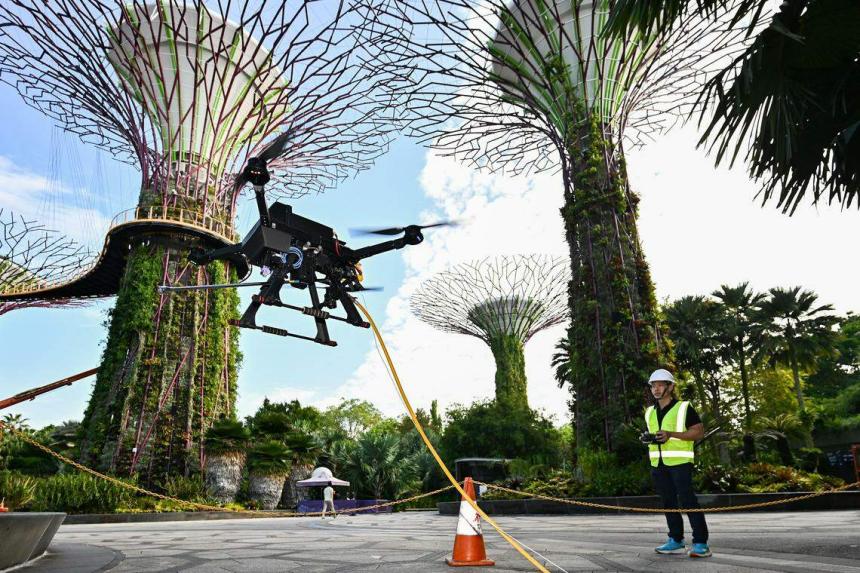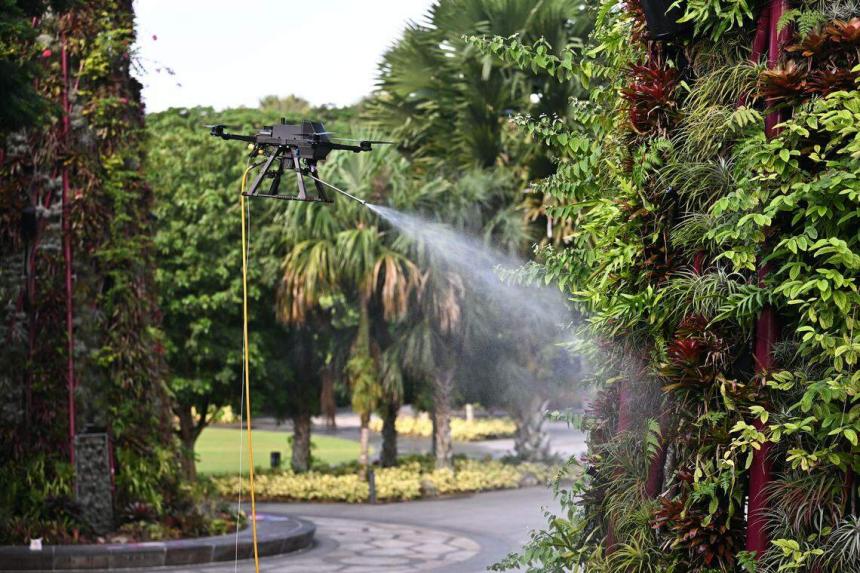SINGAPORE – They fly around the trees, but they are not birds.
Equipped with hosepipes, drones built by the Singapore University of Technology and Design (SUTD) are deployed to clean the Supertrees at Gardens by the Bay.
The iconic, 50m-tall structures that tower over the tourist attraction get hosed down from above as the drones also water the plants on the Supertrees and spray them with fertiliser.
The technology has proved effective in solving the problem of cleaning high structures without having to put humans at risk.
With the drones a boon to supporting operations at the roughly 101ha nature park, Gardens by the Bay is also turning to tech to address manpower challenges and boost efficiency.
The Straits Times on April 4 was given an exclusive first glimpse at how drone technology is mobilised to clean the Supertrees, following a 2023 partnership agreement between Gardens by the Bay and SUTD.
Deputy director of gardens operations Derek Wee, 57, said it takes just under an hour to clean and fertilise the plants on each Supertree, which about halves the time gardeners spend on the 18 Supertrees across the gardens.
Gardeners have to pay special attention to bromeliads – thick-leafed plants with a purple hue – that grow on the trunk’s vertical planting panels alongside ferns and other plants, Mr Wee said.
Bromeliads need to be hosed down to shake off debris and stagnant water to prevent mosquitoes from breeding, and sprayed with fertiliser to keep them healthy.
“It’s usually a very tedious process,” said Mr Wee, who has worked at Gardens by the Bay for more than a decade.
“(When we work on the Supertrees), each boom lift must move around the tree to help the gardeners get into position.”
The boom lifts are slow and bulky, requiring a large perimeter around each Supertree to be cordoned off.
For safety reasons, the lifts can be operated only during daytime, which sets cleaning operations back, Mr Wee said.
On the other hand, the drones are easier to deploy and allow the team to get an earlier start, before the crowds enter the Gardens, he added.
The drone – named Blaster (Better Localised Autonomous Scouring and Tethered Ejecting Rotorcraft) – is specially designed to handle the strong force of water spraying from the hose it carries, said Associate Professor Foong Shaohui of SUTD, who oversees the project.

Weighing roughly 7kg, the Blaster, about the size of a coffee table, is lighter than it looks, as it does not carry batteries or store water.
Instead, it is tethered to a power cable and water pipe connected to the ground.
Tethered drones are safer and typically receive faster clearance from the authorities for flight due to their lower risk of flying free, said Prof Foong, whose team has also tested the use of the drone for other bulky structures, like building facades, aircraft and sheltered walkways.

The team is also in talks with solar farm operators to use drones for cleaning panels deployed on water, which are normally harder to clean, he added.
Using the Blasters has also helped to put fewer workers at risk, said senior director Addison Goh, who oversees attractions operations, security and sustainability at the Gardens.
Just two employees are needed to operate each drone, he said, adding: “While it is safe, we are also trying to reduce the number of people working from heights.”

Since 2023, drone cleaning of the Supertrees has become the standard procedure, and the devices are used at least four times a month in most cleaning jobs.
Mr Goh added that to ensure a smooth transition, SUTD is providing training to his staff on effective drone operation. With less time spent on the Supertrees, gardeners are able to tend to other matters at the Gardens, he said.
The Gardens and SUTD are exploring ways to programme the drone to carry out tasks by itself.

Drones are emerging as a critical safety solution for working at heights, with the Building and Construction Authority encouraging building owners to adopt them for inspections.
The drones join other smart devices deployed across the Gardens, such as autonomous sweepers and autonomous patrol bots, currently being trialled on the walkways and in other areas.
Sensors to track environmental conditions that affect plants, such as temperature, light and humidity, and the water quality in the lakes across Gardens by the Bay are also being tested.



